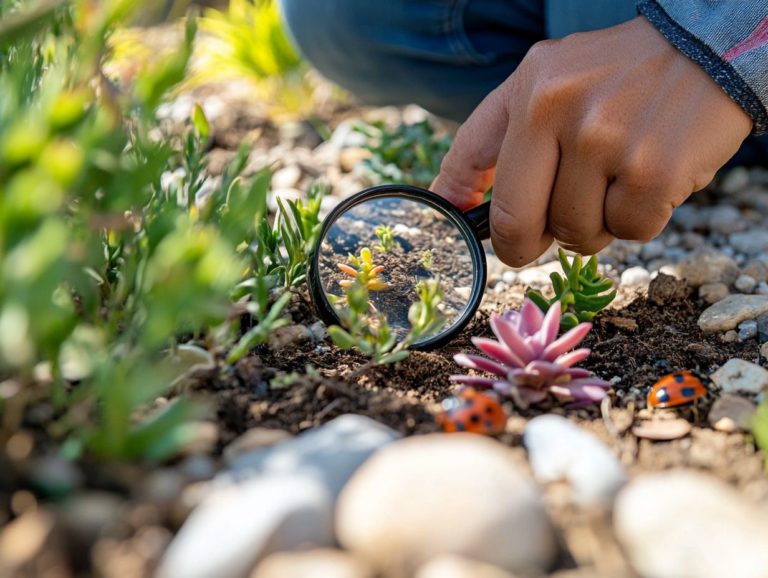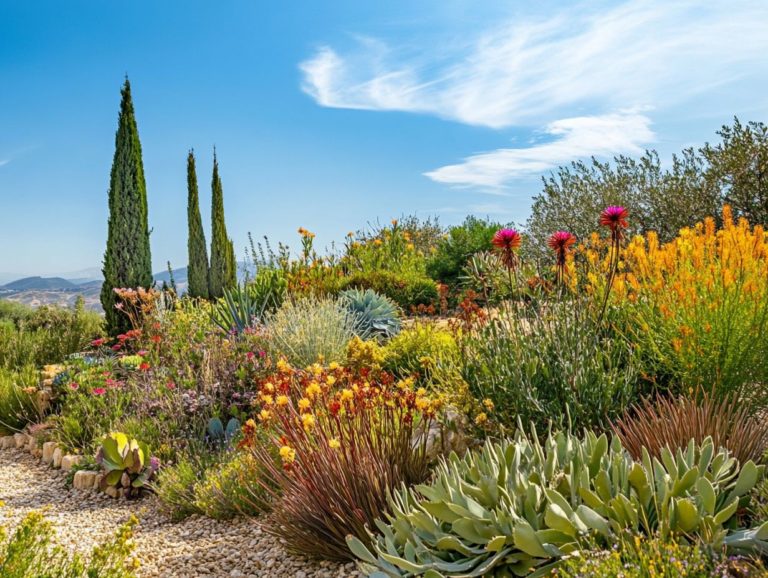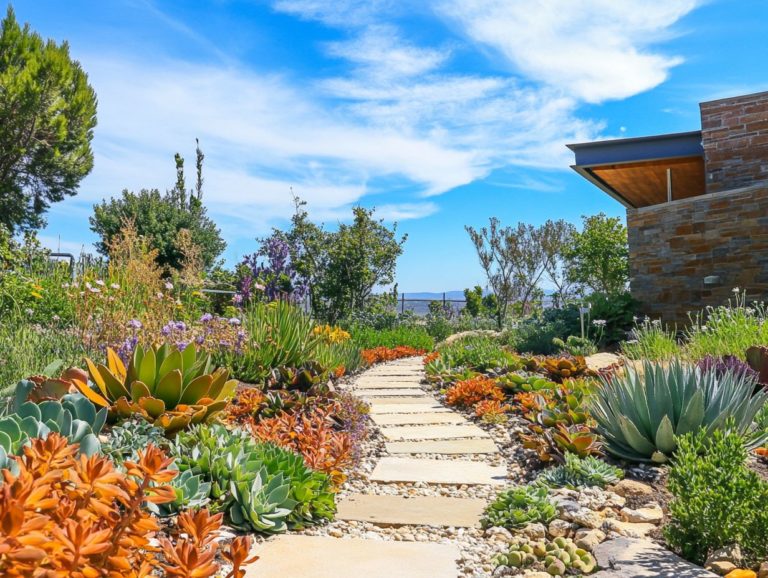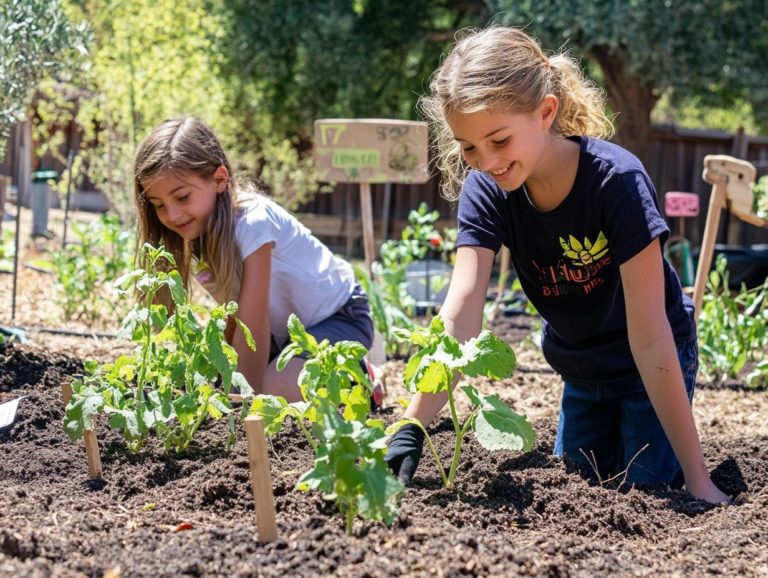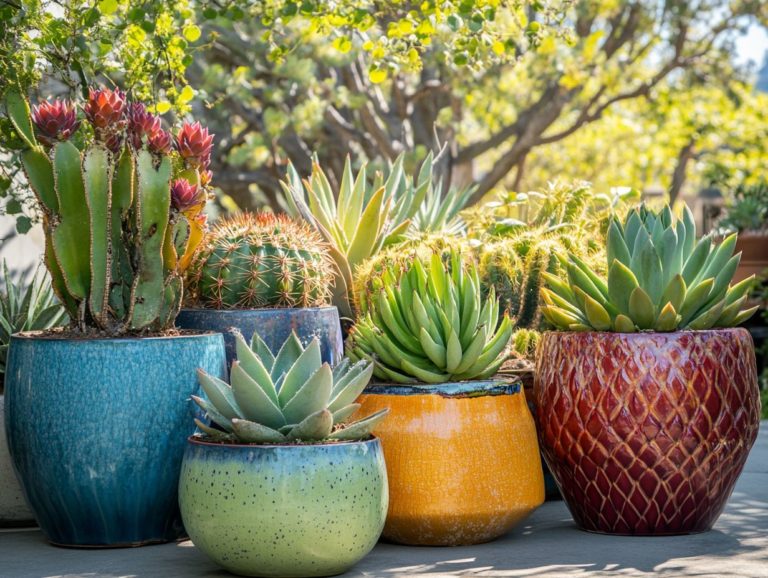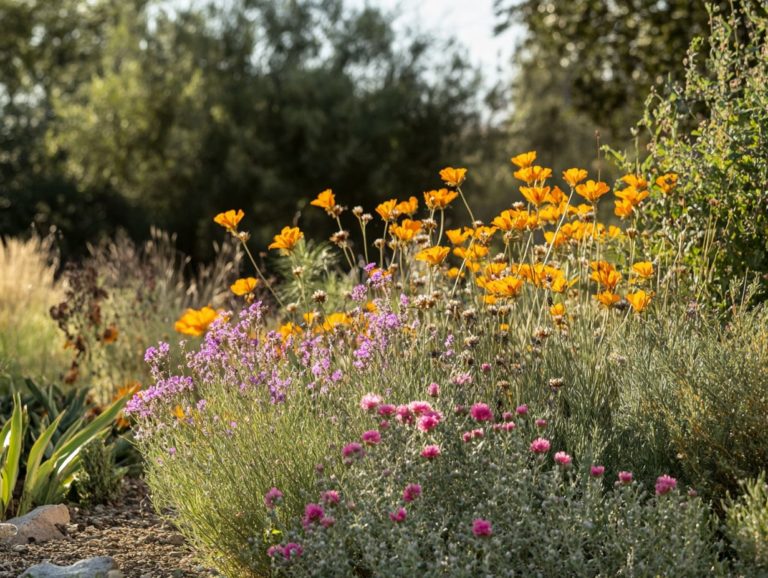How Do Drought-Resistant Plants Conserve Moisture?
As climate change escalates and water scarcity emerges as a critical issue, integrating drought-resistant plants into your landscape has never been more essential. These resilient species not only flourish in tough conditions but also support sustainable gardening practices.
You will also explore the unique adaptations that enable these plants to conserve moisture. You’ll discover various types along with their distinctive characteristics. Additionally, you ll receive creative gardening tips designed to enhance your outdoor spaces while minimizing water usage.
Imagine creating a stunning, eco-friendly garden that truly captivates!
Contents
- Key Takeaways:
- The Importance of Drought-Resistant Plants
- Adaptations for Conserving Moisture
- Types of Drought-Resistant Plants
- Caring for Drought-Resistant Plants
- Landscaping with Drought-Resistant Plants
- Frequently Asked Questions
- How do drought-resistant plants conserve moisture?
- What are some common adaptations that help drought-resistant plants conserve moisture?
- Do drought-resistant plants require less water than other plants?
- Can I grow drought-resistant plants in any climate?
- How can I incorporate drought-resistant plants into my garden?
- Are there any other benefits to using drought-resistant plants?
Key Takeaways:
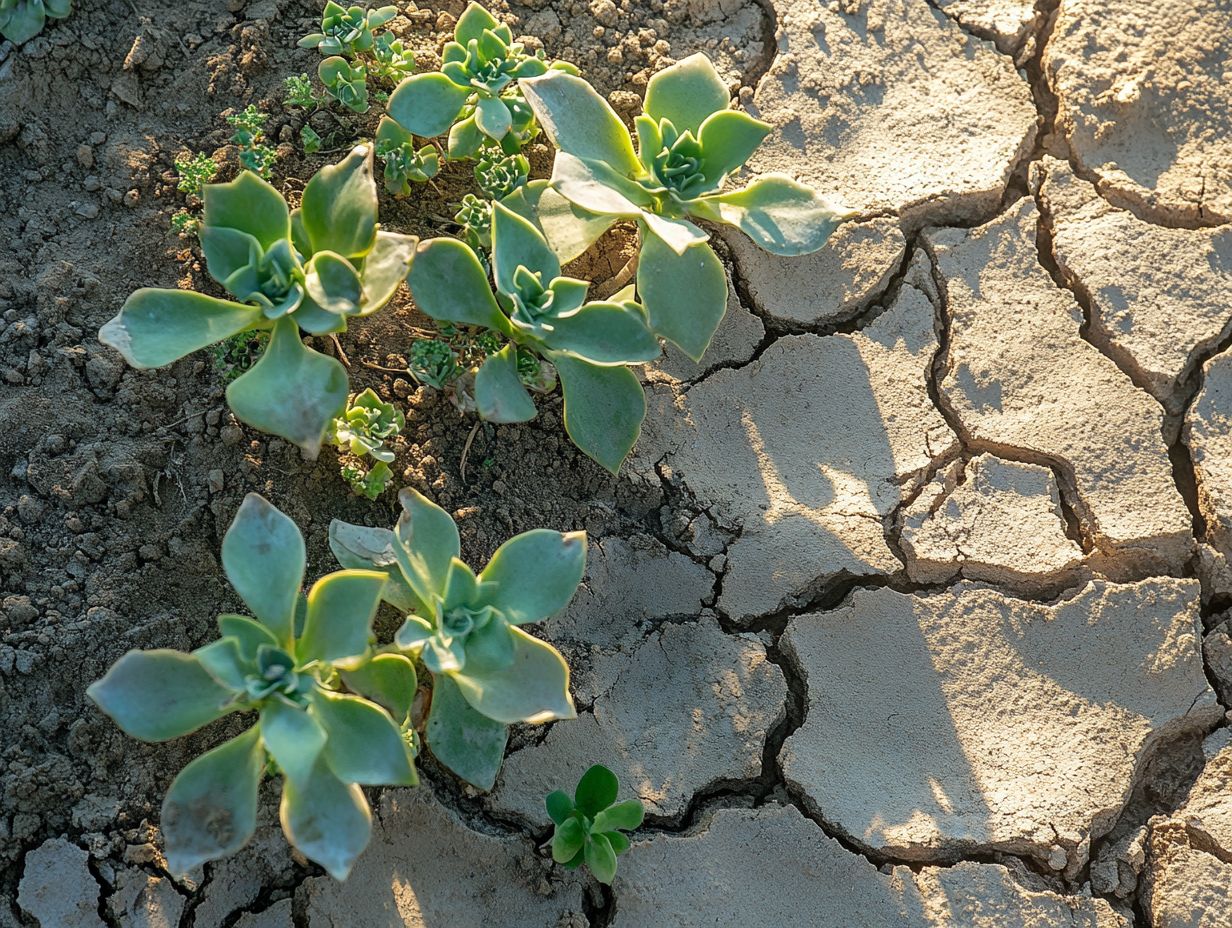
- Drought-resistant plants are essential for conserving water in areas with limited rainfall, reducing the need for constant watering and maintenance, particularly in regions like California, Texas, and the Southwest.
- These plants have special features that help them save water and survive in dry conditions.
- By incorporating drought-resistant plants into our landscaping and following proper care and maintenance practices, we can create beautiful and sustainable landscapes that require less water.
The Importance of Drought-Resistant Plants
Drought-resistant plants are essential for promoting water conservation and enhancing the sustainability of your garden, particularly in regions grappling with climate change, such as California, Texas, and the Southwest. Incorporating drought-resistant plants can greatly contribute to this effort.
These resilient plants thrive in low moisture environments and support local wildlife. They also improve soil health, making them a wise choice for today s gardener.
Their deep root systems enhance their drought resistance. By integrating these plants into your landscape, you not only combat the effects of drought but also cultivate beautiful, eco-friendly spaces that elevate both your garden and the environment, all while promoting healthy soil.
Why Choose Drought-Resistant Plants?
Choosing drought-resistant plants opens the door to numerous benefits, including significantly reduced irrigation needs and low maintenance requirements. This makes them a perfect fit for sustainable gardening practices in various gardening zones.
Opting for these resilient varieties lets you create vibrant landscapes while conserving both water and time. These plants are specially adapted to thrive under various conditions, giving you versatility across diverse gardening zones. Their hardiness also means they re less susceptible to pests and diseases, which further cuts down the need for chemical treatments. This not only benefits the environment but also aligns seamlessly with the growing trend of eco-friendly gardening.
Embracing drought-resistant plants is a savvy choice that supports biodiversity and ensures your garden flourishes, even in challenging climates.
Adaptations for Conserving Moisture
Drought-resistant plants have developed a range of impressive adaptations for conserving moisture, enabling them to flourish in arid environments where many others struggle. Their remarkable resilience is evident in features such as deep root systems and the ability to manage water levels, as well as pressure that helps keep cells firm. To learn more about how drought-resistant plants save water, explore their traits that allow them to endure and thrive despite challenging conditions.
Physical Characteristics
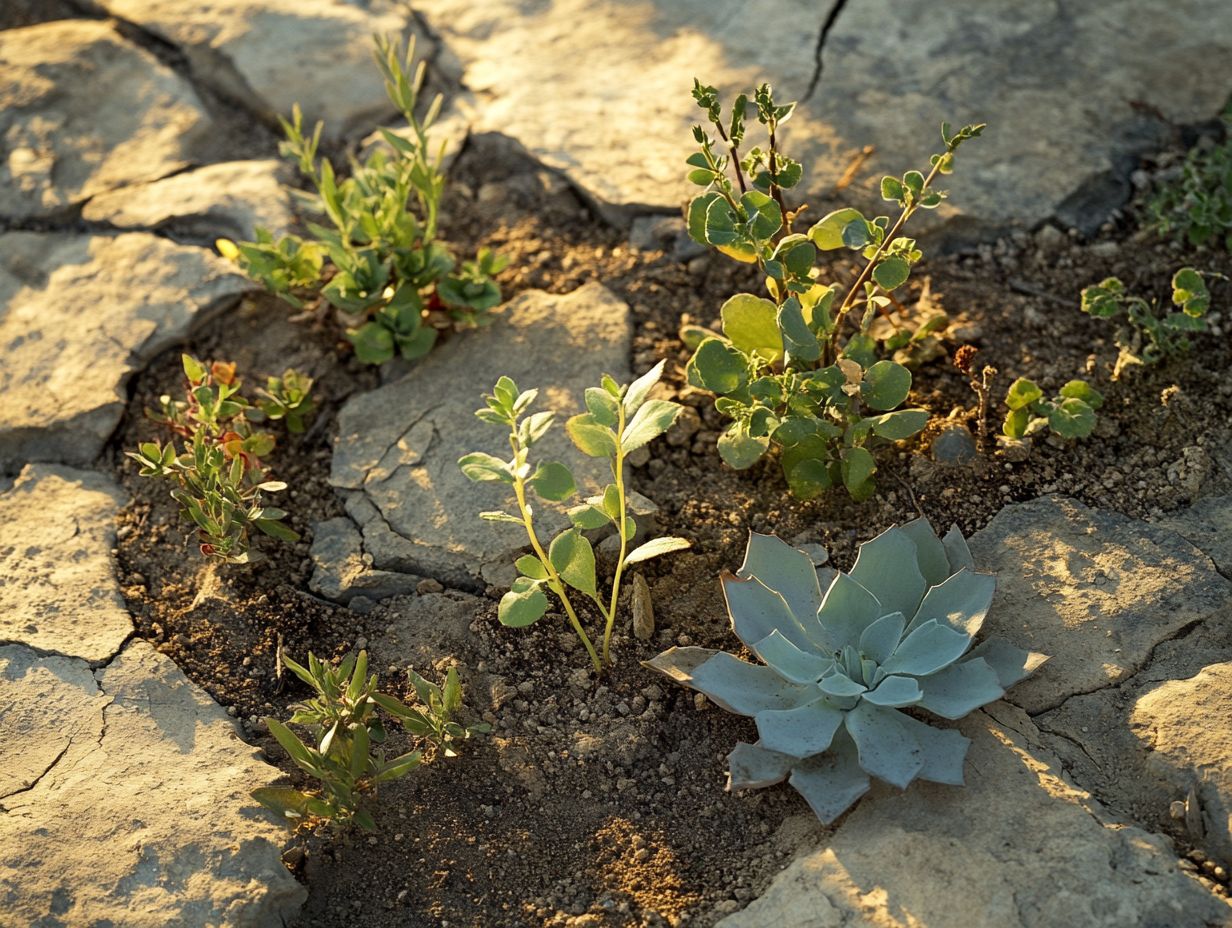
The physical traits of drought-resistant plants, such as thick leaves and waxy surfaces, are crucial for their survival in dry conditions. To learn more about maintaining these plants, consider exploring how to keep drought-resistant plants healthy. Take the remarkable resurrection plants, for example; they showcase an extraordinary ability to endure extreme drought.
These amazing adaptations help them save water and thrive when the rain is scarce! If you’re interested in selecting the best options, learning how to choose drought-resistant plants can be incredibly beneficial. Some plants feature deep root systems that reach underground water reserves, while others develop fleshy stems specifically designed for water storage.
If you’re a gardener looking to retain soil moisture, using organic mulch around these plants is essential. It serves as a barrier against evaporation and enhances soil health.
By combining natural adaptations with strategic gardening practices, like grouping plants with similar water needs, you can significantly boost the resilience of these remarkable plants in arid environments.
Behavioral Strategies
Behavioral strategies utilized by drought-resistant plants, such as closing their stomata during the hottest part of the day and adjusting their growth patterns, are crucial for maximizing water conservation. To learn more about these plants, check out the most resilient drought-resistant plants across various gardening zones.
These adaptive mechanisms enable resilient organisms to thrive even in challenging environments where water scarcity presents a significant hurdle. For instance, some species have developed deeper root systems that tap into underground moisture, while others reduce their leaf surface area to minimize evaporation. If you’re interested in incorporating such plants into your garden, you might want to explore the best drought-resistant plants, which often have specialized waxy coatings on their leaves to reduce water loss.
By embracing such strategies, drought-resistant plants not only survive but flourish in diverse climates, making them an invaluable asset for anyone looking to cultivate sustainable outdoor spaces.
Types of Drought-Resistant Plants
You have an impressive selection of drought-resistant plants at your disposal, perfect for a variety of landscapes. Consider the allure of Echinacea, the calming presence of Lavender, and the graceful form of Little Bluestem.
Each of these options brings its own distinct characteristics, enhancing your garden’s beauty while ensuring resilience in the face of drought and other challenging conditions.
Examples and Characteristics
Consider incorporating some exceptional drought-resistant plants into your garden, such as Echinacea, celebrated for its vibrant flowers; Lavender, renowned for its aromatic charm; and Red Yucca, which has a knack for attracting hummingbirds. These selections not only adapt beautifully to arid conditions but also champion sustainable gardening practices.
- Echinacea, also known as coneflower, delights the eyes and attracts pollinators, enriching biodiversity while demanding minimal water.
- Lavender enchants with its calming scent and vibrant colors, making it perfect for herb gardens, reducing your reliance on chemical pest controls while supporting biodiversity.
- Red Yucca stands tall with its stunning blooms, attracting graceful hummingbirds to your garden.
Together, these plants beautifully illustrate the harmony of aesthetics and functionality in eco-friendly landscaping.
Caring for Drought-Resistant Plants
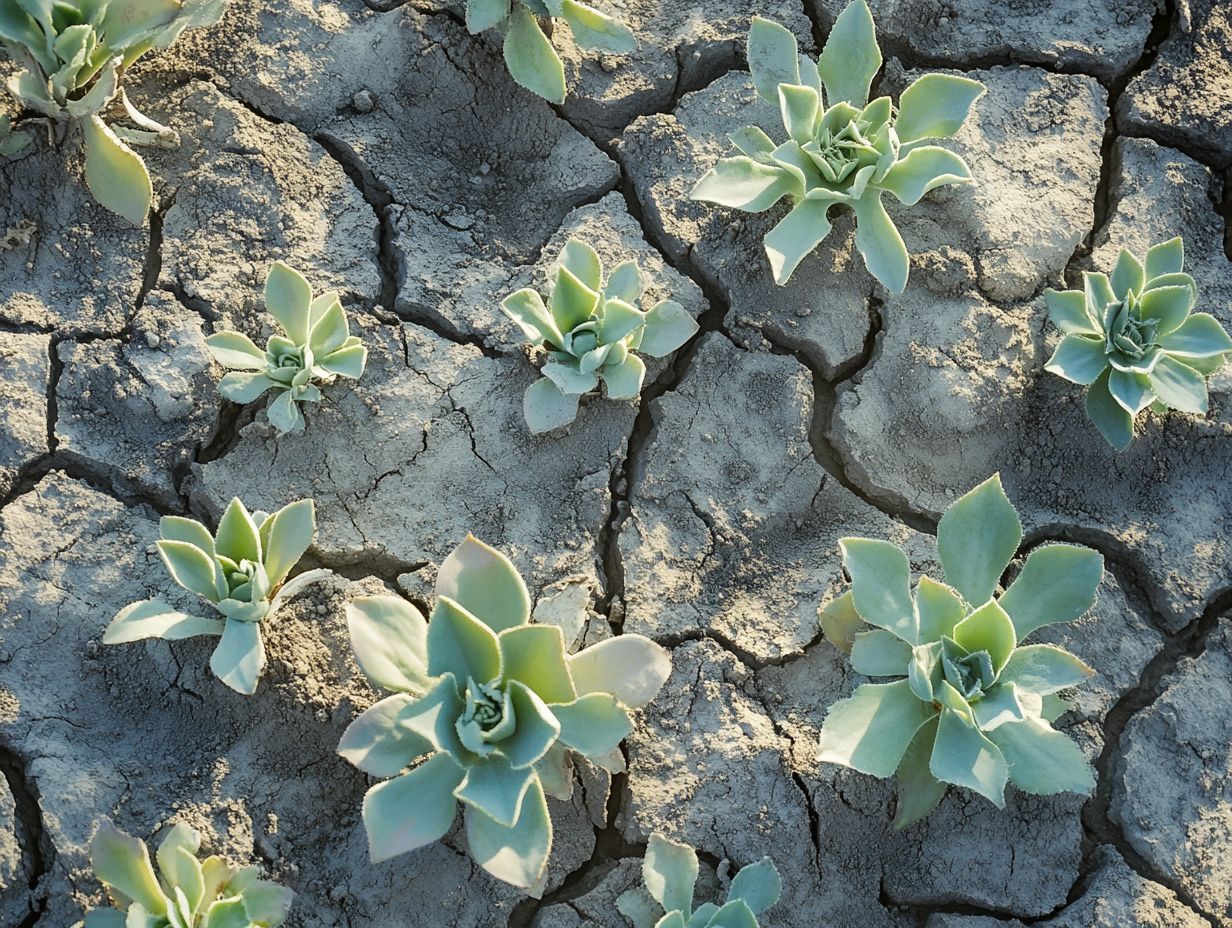
Caring for drought-resistant plants involves adopting best practices that help them thrive. Use organic mulch to retain moisture and enhance soil health.
Minimize irrigation to bolster their drought resilience. By doing this, you ll empower these resilient plants and take a big step toward sustainable gardening!
Best Practices for Maintenance
To ensure your drought-resistant plants last, follow best maintenance practices. Reduce irrigation and use effective mulching techniques.
These approaches help create a sustainable environment. This not only supports plant health but also conserves precious water resources.
Techniques like drip systems and deep watering promote deeper root growth. This enhances your plants’ resilience against dry conditions.
Incorporating organic mulch is a game-changer. It retains moisture and suppresses weeds, contributing to a thriving ecosystem.
Materials like straw, wood chips, or shredded leaves enrich soil fertility. Over time, this promotes the overall health of your drought-resistant plants.
Embrace these strategies to see your garden truly flourish, even in challenging climatic conditions.
Landscaping with Drought-Resistant Plants
Landscaping with drought-resistant plants boosts the visual appeal of your outdoor space. It also promotes environmental sustainability, creating a garden that benefits everyone.
Consider using innovative design techniques like grouping plants by their water needs. This fosters a harmonious ecosystem supporting local wildlife.
Design Tips and Ideas
Using design techniques like grouping plants can elevate your garden’s look. This method makes it easier to optimize irrigation and minimize waste.
By choosing species native to your climate, you cultivate a vibrant ecosystem. This supports local birds and pollinators.
Incorporating rocks, mulch, and organic materials aids moisture retention. This allows resilient plants to thrive in tough conditions.
Play with colors, textures, and varying plant heights. This transforms your landscape into an inviting, environmentally sustainable space.
Frequently Asked Questions
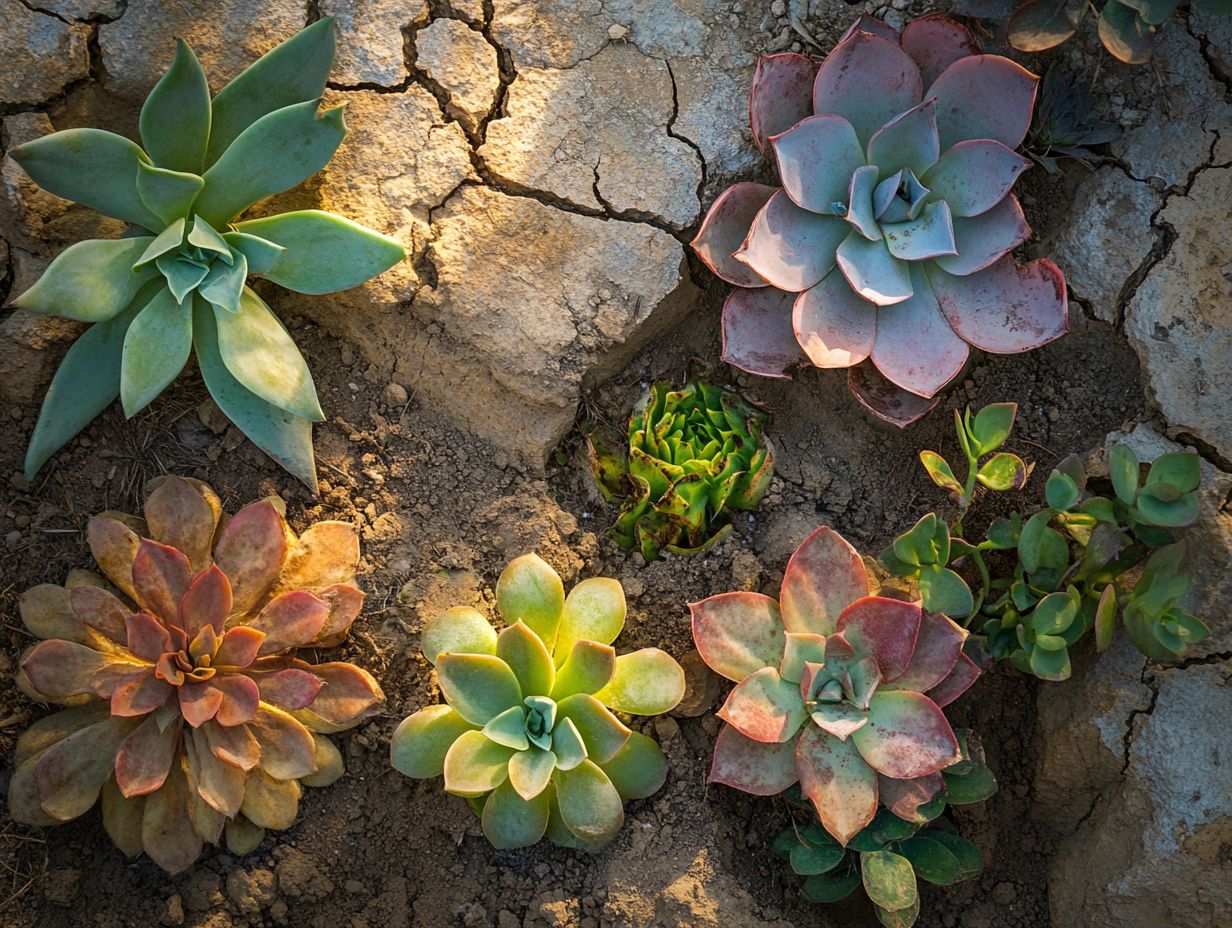
How do drought-resistant plants conserve moisture?
Drought-resistant plants have unique adaptations to survive in dry conditions. To learn more about these adaptations, check out key features of drought-resistant plants that help them use moisture efficiently.
What are some common adaptations that help drought-resistant plants conserve moisture?
Common adaptations include small or waxy leaves and deep root systems. To learn more about selecting the best options for your garden, check out this guide on how to choose drought-resistant plants. They can also close their stomata during hot, dry periods.
Do drought-resistant plants require less water than other plants?
Yes, these plants thrive with less water due to their adaptations. They still need water to survive and grow, though.
Can I grow drought-resistant plants in any climate?
These plants are best for dry and arid climates. Some varieties can also grow in moderate climates with less frequent watering.
How can I incorporate drought-resistant plants into my garden?
Choose varieties native to your region and group them by watering needs. This creates an effective garden layout.
Are there any other benefits to using drought-resistant plants?
Yes! They attract pollinators, require less maintenance, and are resistant to pests and diseases.

